Capturing Remote Wi-Fi Traffic on OpenWRT with Wireshark
Overview
I’ll explain how I transformed my OpenWrt access point into a remote Wi-Fi packet capture device. By leveraging SSH, tcpdump, and a custom channel hopping script, I can stream live Wi-Fi traffic directly into Wireshark on my Windows PC without needing physical access to the router.
I used a Netgear R7450 AC2600 to set this up.
I aimed to capture Wi-Fi packets remotely by putting my OpenWrt device into monitor mode and streaming the data over SSH. The main challenges I encountered were:
- Device Mode Configuration: Initially, setting up monitor mode correctly on the device was tricky. Using the wrong interface parameters led to errors.
- Channel Hopping: My device uses two radios—one for 2.4GHz and one for 5GHz. I needed a way to cycle through channels to capture a comprehensive range of traffic.
1. Configuring Monitor Mode
I used the following commands to push my radio cards into monitoring mode:
1
2
iw phy phy0 interface add mon0 type monitor
iw phy phy1 interface add mon1 type monitor
I ensured both wireless interfaces were set to monitor mode. Running the command:
1
OpenWrt:~# iw dev
yielded the following configuration:
1
2
3
4
5
6
7
8
9
10
11
12
13
14
15
16
phy#1
Interface mon1
ifindex 16
wdev 0x100000004
addr c8:9e:43:e2:d0:66
type monitor
channel 48 (5240 MHz), width: 20 MHz (no HT), center1: 5240 MHz
txpower 20.00 dBm
phy#0
Interface mon0
ifindex 15
wdev 0x4
addr c8:9e:43:e2:d0:65
type monitor
channel 7 (2442 MHz), width: 20 MHz (no HT), center1: 2442 MHz
txpower 20.00 dBm
This confirmed that the interfaces were ready for packet capture.
2. Implementing Channel Hopping
To cover the entire Wi-Fi spectrum, I created a dual-band channel hopping script. This script cycles through the supported channels for both the 2.4GHz (mon0) and 5GHz (mon1) interfaces.
Here’s the final version of the script:
1
2
3
4
5
6
7
8
9
10
11
12
13
14
15
16
17
18
19
20
21
22
23
24
25
26
27
28
29
30
31
32
33
34
35
36
37
38
39
40
41
#!/bin/sh
IFACE_24="mon0"
IFACE_5="mon1"
CHANNELS_24="1 2 3 4 5 6 7 8 9 10"
CHANNELS_5="36 40 44 48"
DWELLTIME_24=1
DWELLTIME_5=1
command -v iw >/dev/null 2>&1 || { echo "Error: iw not found. Please install it."; exit 1; }
command -v sleep >/dev/null 2>&1 || { echo "Error: sleep not found. Please install it."; exit 1; }
if [ "$(id -u)" -ne 0 ]; then
echo "Error: This script must be run as root." >&2
exit 1
fi
echo "Starting channel hopping..."
echo " $IFACE_24 (2.4GHz) channels: $CHANNELS_24"
echo " $IFACE_5 (5GHz) channels: $CHANNELS_5"
echo "Dwell times: ${DWELLTIME_24}s (2.4GHz), ${DWELLTIME_5}s (5GHz)"
channel_hop() {
INTERFACE="$1"
CHANNELS="$2"
DWELL="$3"
while true; do
for CH in $CHANNELS; do
echo "Setting $INTERFACE to channel $CH"
iw dev "$INTERFACE" set channel "$CH" 2>/dev/null
if [ $? -ne 0 ]; then
echo "Warning: Failed to set $INTERFACE to channel $CH"
fi
sleep "$DWELL"
done
done
}
channel_hop "$IFACE_24" "$CHANNELS_24" "$DWELLTIME_24" &
PID_24=$!
channel_hop "$IFACE_5" "$CHANNELS_5" "$DWELLTIME_5" &
PID_5=$!
echo "Channel hopping started:"
echo " $IFACE_24 (2.4GHz) - PID $PID_24"
echo " $IFACE_5 (5GHz) - PID $PID_5"
echo "Press Ctrl+C to stop."
wait
This script, adjusted for my device’s regulatory domain, excludes unsupported channels and those requiring DFS, which did take me a while to figure out.
3. Running the Capture
With the channel hopper active, capturing the Wi-Fi traffic was straightforward. To capture 5 GHz, I used interface mon1.

Once started, Wireshark begins displaying the live packet capture streamed from the router over SSH.

